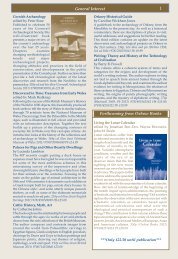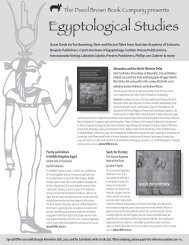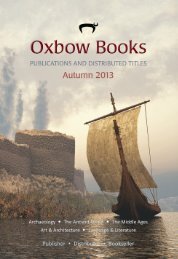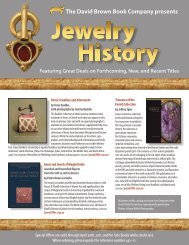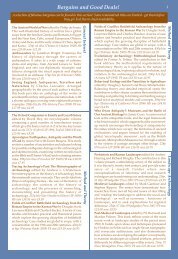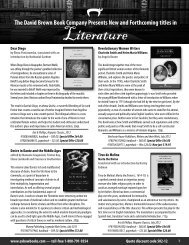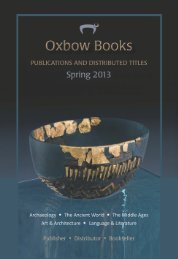New Distributed Titles Fall 2009 - Oxbow Books
New Distributed Titles Fall 2009 - Oxbow Books
New Distributed Titles Fall 2009 - Oxbow Books
You also want an ePaper? Increase the reach of your titles
YUMPU automatically turns print PDFs into web optimized ePapers that Google loves.
itish archaeology<br />
Excavations and Observations<br />
in Roman Cirencester, 1998–2007<br />
edited by Neil Holbrook<br />
This volume presents the results of a number of excavations undertaken<br />
in Cirencester in the last decade which have examined houses, shops,<br />
public buildings (including the forum), town defenses and cemeteries.<br />
Excavations within insula IX found a previously unrecorded corridor<br />
mosaic, while work within the western cemetery has revealed interesting<br />
evidence for early Roman cremation ritual, along with later Roman<br />
inhumation burials. The publication of this volume marks the fiftieth<br />
anniversary of the formation of the Cirencester Excavation Committee,<br />
and an introductory essay charts the changing circumstances in which<br />
archaeology has been practiced in the town over the last fifty years.<br />
158p, paperback, 9780955353420, $30.00, Cotswold Archaeology,<br />
December 2008, Cirencester Excavations VI.<br />
Tracks through Time<br />
Archaeology and History<br />
from the East London Line Project<br />
by Aaron Birchenough, George Dennis, Emma Dwyer,<br />
Nicholas Elsden, Hana Lewis and Susan M Wright<br />
The East London Line Project presented a unique opportunity, as<br />
structures were demolished and cleared for London’s latest railway, to<br />
discover more about some of London’s earliest railways. This included<br />
previously undiscovered parts of one of the world’s first operational<br />
passenger railways, the Eastern Counties of 1840. The new construction<br />
led to important archaeological discoveries, particularly at the site of<br />
Holywell Priory and beneath Bishopsgate Goods Yard in Shoreditch.<br />
64p, col illus, paperback, 9781901992878, $19.95,<br />
Museum of London Archaeological Service, July <strong>2009</strong>.<br />
34<br />
The Glass-Blowers of Roman London<br />
by John Shepherd and Angela Wardle<br />
Recycling may be a topical subject today, but it is an ancient practice.<br />
Glass was regularly recycled to make new vessels during the<br />
Roman period and important new evidence for glass working in<br />
London came from 35 Basinghall Street in the City, with the discovery,<br />
in 2005, of over 70 kg of broken vessel glass and production<br />
waste. This ranges from large blocks, cooled in a tank furnace,<br />
to minute threads swept from a workshop floor. Particularly impressive<br />
are thousands of moils the small cylinder of glass left on<br />
the end of the blowing iron when a vessel was detached, each<br />
representing the making of a single product.<br />
64p, col illus, paperback, 9781901992847, $13.95, Museum of London Archaeological Service, September <strong>2009</strong>.<br />
Housesteads Roman Fort –<br />
The Grandest Station<br />
Excavation and Survey, 1954–95<br />
by Alan Rushworth<br />
Housesteads is one of the most important forts on<br />
Hadrian’s Wall. Extensive excavations were carried<br />
out between 1874 and 1981 by <strong>New</strong>castle University.<br />
Combining the results with those of excavations done<br />
between 1959 and 1961 by Durham University, a<br />
complete plan of the northeast part of the fort is now<br />
available. This two-volume report documents the excavations<br />
and gives full finds reports.<br />
2 vols, 742p, 308, paperback, 9781848020269, $200.00(s), English Heritage, October <strong>2009</strong>.<br />
London’s Roman Amphitheatre<br />
Guildhall Yard, City of London<br />
by Nick Bateman, Carrie Cowan<br />
and Robin Wroe-Brown<br />
The discovery of one of Roman London’s most significant<br />
buildings – its amphitheater – underneath the<br />
medieval Guildhall resulted from major archaeological<br />
excavations which took place between 1985 and 1999<br />
as part of the City of London Corporations ambitious<br />
program of redevelopment at the Guildhall. This book<br />
describes the construction, development and disuse of<br />
the amphitheater, from the 1st to 4th centuries AD. The evidence allows conjectural reconstruction<br />
and comparison with other British amphitheaters.<br />
259p, 176 col & b/w illus, 12 tbls, hardback, 9781901992717, $60.00,<br />
Museum of London Archaeological Service, December 2008, MoLAS Monograph Series.<br />
The David Brown Book Company – <strong>Fall</strong> <strong>2009</strong>




